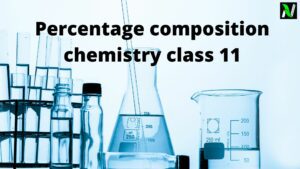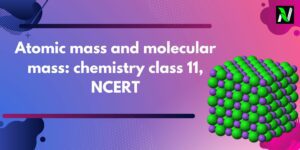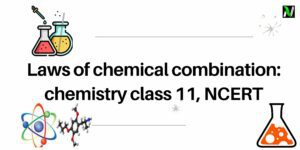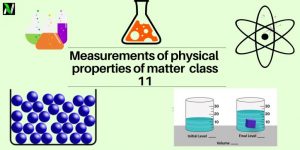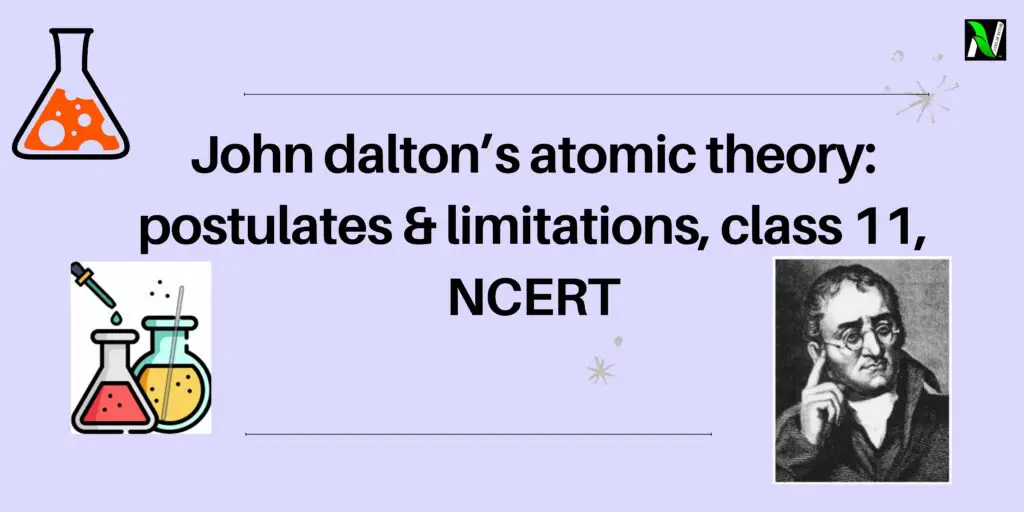
Although the origin of the idea that matter is made up of small indivisible particles called “atomio” (meaning “indivisible”) dates back to the time of the Greek philosopher Democritus (460-370 BC). In 1808 Dalton published a new system of chemical philosophy, which was called later john dalton’s atomic theory.
In this article, we discuss John dalton’s atomic theory: postulates & limitations, so let’s get started…
What is john dalton’s atomic theory?
Dalton’s atomic theory was a scientific theory about the nature of matter proposed by English physicist and chemist John Dalton in 1808. It held that all matter is made up of small, indivisible particles known as “atoms”.
According to Dalton’s atomic theory, all substances are made up of atoms, which are indivisible and indestructible building blocks. While the atoms of an element were all the same size and mass, different elements had atoms of different sizes and masses.
Read Also
- Uncertainty in measurement chemistry, class 11 NCERT
- Laws of chemical combination: chemistry class 11, NCERT
Postulates of Dalton’s Atomic Theory
In the new system of chemical philosophy, published in 1808. He proposed the following.
- All matter is made up of tiny, indivisible particles called atoms.
- All atoms of a given element have identical properties, including the same mass. Atoms of different elements differ in mass.
- Atoms can neither be created nor destroyed. Furthermore, atoms cannot be divided into smaller particles.
- Atoms of different elements can combine with each other in fixed whole-number ratios in order to form compounds.
- Chemical reactions involve the reorganization of atoms. These are neither created nor destroyed in a chemical reaction.
Limitations of Dalton’s Atomic Theory
- It takes no account of subatomic particles: Dalton’s atomic theory states that atoms are indivisible. However, the discovery of subatomic particles (such as protons, electrons, and neutrons) disproved this postulate.
- Isotopes are not taken into account here: According to Dalton’s atomic theory, all atoms of an element have identical masses and densities. However, different isotopes of elements have different atomic masses (example: hydrogen, deuterium, and tritium).
- Doesn’t account for isobars: This theory states that the masses of atoms of two different elements must differ. However, it is possible for two different elements to have the same mass number. These atoms are called isobars (for example 40Ar and 40Ca).
- Elements do not have to be combined in simple integer ratios to form compounds: certain complex organic compounds do not have simple ratios of constituent atoms. Example: sugar/sucrose (C11H22O11).
- The theory does not account for allotropes: the differences in the properties of diamond and graphite, which contain only carbon, cannot be explained using the dalton atomic theory.
Merits of Dalton’s Atomic Theory
- Dalton’s atomic theory does not violate the law of multiple proportions, the law of conservation of mass, and the law of constant proportions.
- The theory provides a basis for distinguishing between elements and compounds.
Demerits of Dalton’s Atomic Theory
Below are some major demerits of Dalton’s atomic theory.
- The theory did not explain the existence of subatomic particles (it suggests that atoms are indivisible).
- By assuming that all atoms of an element must have identical masses and sizes, Dalton’s atomic theory does not explain the existence of isotopes. In addition, this theory does not explain the existence of isobars (nuclides of different chemical elements with the same mass number).
- Dalton’s atomic theory failed to explain the differences in the properties of different allotropes of an element.
- This theory states that elements must combine in simple integer ratios to form compounds. However, this is not necessarily true. Several complex organic compounds do not have simple parts in their constituent elements.
Watch this video for more reference:
Frequently Asked Questions – FAQs
How does Dalton’s atomic theory explain the law of conservation of mass?
Because it states that atoms can neither be created nor destroyed, Dalton’s theory suggests that the net mass of the species involved in a chemical reaction is conserved. So this postulate explains the law of conservation of mass.
How does Dalton’s atomic theory differentiate between elements and compounds?
This theory states that elements combine in fixed integer ratios to form compounds. Hence, it suggests that compounds are made up of molecules containing two or more atoms of different elements.
What are the 5 key postulates of Dalton’s atomic theory?
The 5 postulates of Dalton’s atomic theory are listed below.
1). All matter is made up of tiny, indivisible particles called atoms.
2). All atoms of a given element have identical properties, including the same mass. Atoms of different elements differ in mass.
3). Atoms can neither be created nor destroyed. Furthermore, atoms cannot be divided into smaller particles.
4). Atoms of different elements can combine with each other in fixed whole-number ratios in order to form compounds.
5). Chemical reactions involve the reorganization of atoms. These are neither created nor destroyed in a chemical reaction.
Why is Dalton’s atomic theory important?
One of the most important virtues of Dalton’s atomic theory is the fact that the theory does not violate several fundamental laws of chemical combination, such as the law of definite proportions, the law of multiple proportions, and the law of conservation of mass
How many atoms are in the world?
According to the US Department of Energy’s Jefferson Lab, the numbers of atoms in the world is: 133,000,000,000,000,000,000,000,000,000,000,000,0
Can atoms be divided or destroyed?
No, atoms can not be divided or destroyed. However Chemical reactions involve the reorganization of atoms. These are neither created nor destroyed in a chemical reaction.
Stay tuned with Laws Of Nature for more useful and interesting content.



